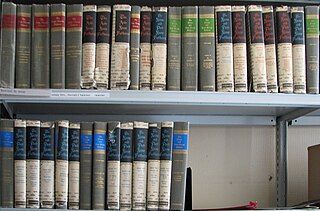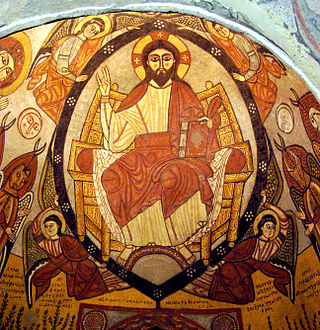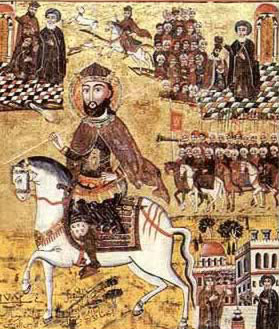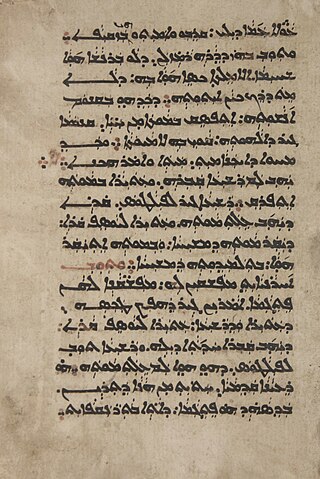Related Research Articles

Ephrem the Syrian, also known as Saint Ephrem, Saint Ephraim, Ephrem of Edessa or Aprem of Nisibis, was a prominent Christian theologian and writer, who is revered as one of the most notable hymnographers of Eastern Christianity. He was born in Nisibis, served as a deacon and later lived in Edessa.
The Syriac language, also known as Syriac Aramaic and Classical Syriac ܠܫܢܐ ܥܬܝܩܐ, is an Aramaic dialect that emerged during the first century AD from a local Aramaic dialect that was spoken in the ancient region of Osroene, centered in the city of Edessa. During the Early Christian period, it became the main literary language of various Aramaic-speaking Christian communities in the historical region of Ancient Syria and throughout the Near East. As a liturgical language of Syriac Christianity, it gained a prominent role among Eastern Christian communities that used both Eastern Syriac and Western Syriac rites. Following the spread of Syriac Christianity, it also became a liturgical language of eastern Christian communities as far as India and China. It flourished from the 4th to the 8th century, and continued to have an important role during the next centuries, but by the end of the Middle Ages it was gradually reduced to liturgical use, since the role of vernacular language among its native speakers was overtaken by several emerging Neo-Aramaic dialects.

The Syriac Orthodox Church, also known as West Syriac Church or West Syrian Church, officially known as the Syriac Orthodox Patriarchate of Antioch and All the East, and informally as the Jacobite Church, is an Oriental Orthodox church that branched from the Church of Antioch. The bishop of Antioch, known as the patriarch, heads the church and possesses apostolic succession through Saint Peter, according to sacred tradition. The church upholds Miaphysite doctrine in Christology, and employs the Divine Liturgy of Saint James, associated with James, the brother of Jesus. Classical Syriac is the official and liturgical language of the church.

Akre or Aqrah is a disputed city in northern Iraq. The Iraqi Government officially considers it part of the Ninawa Governorate while the Kurdistan Regional Government claims it as part of the Duhok Governorate. Akre is known for its celebrations of Newroz.

Hunayn ibn Ishaq al-Ibadi (Arabic: أبو زيد حنين بن إسحاق العبادي; ʾAbū Zayd Ḥunayn ibn ʾIsḥāq al-ʿIbādī was an influential Arab Nestorian Christian translator, scholar, physician, and scientist. During the apex of the Islamic Abbasid era, he worked with a group of translators, among whom were Abū 'Uthmān al-Dimashqi, Ibn Mūsā al-Nawbakhti, and Thābit ibn Qurra, to translate books of philosophy and classical Greek and Persian texts into Arabic and Syriac.

Syriac Christianity is a branch of Eastern Christianity of which formative theological writings and traditional liturgies are expressed in the Classical Syriac language, a variation of the old Aramaic language. In a wider sense, the term can also refer to Aramaic Christianity in general, thus encompassing all Christian traditions that are based on liturgical uses of Aramaic language and its variations, both historical and modern.
Jacob of Edessa was Bishop of Edessa and prominent Syriac Christian writer in Classical Syriac language, also known as one of earliest Syriac grammarians. In various works, he treated theological, liturgical, canonical, philosophical and historical subjects, and contributed significantly to scholarly and literary development of Syriac Christianity. He is considered to be one of the most important scholars of the Christian-Aramean tradition.

Patristics or patrology is the study of the early Christian writers who are designated Church Fathers. The names derive from the combined forms of Latin pater and Greek patḗr (father). The period of the Church Fathers, commonly called the Patristic era, is generally considered to run from the end of New Testament times or end of the Apostolic Age to either AD 451 or to the Second Council of Nicaea in 787.

Syriac literature is literature in the Syriac language. It is a tradition going back to the Late Antiquity. It is strongly associated with Syriac Christianity.

The Doctrine of Addai is a Syriac Christian text, written in the late 4th or early 5th century CE. It recounts the legend of the Image of Edessa as well as the legendary works of Addai and his disciple Mari in Mesopotamia.

Saint Michael the Syrian ,(Classical Syriac: ܡܺܝܟ݂ܳܐܝܶܠ ܣܽܘܪܝܳܝܳܐ, romanized: Mīkhoʾēl Sūryoyo), died 1199 AD, also known as Michael the Great or Michael Syrus or Michael the Elder, to distinguish him from his nephew, was a patriarch and saint of the Syriac Orthodox Church from 1166 to 1199. He is best known today as the author of the largest medieval Chronicle, which he wrote in the Syriac language. Some other works and fragments written by him have also survived.
Ignatius Niʿmatallah was the Patriarch of Antioch and head of the Syriac Orthodox Church from 1557 until his resignation in 1576.

Agnes Smith Lewis (1843–1926) and Margaret Dunlop Gibson (1843–1920), nées Smith, were English Semitic scholars and travellers. As the twin daughters of John Smith of Irvine, Ayrshire, Scotland, they learned more than 12 languages between them, specialising in Arabic, Christian Palestinian Aramaic, and Syriac, and became acclaimed scholars in their academic fields, and benefactors to the Presbyterian Church of England, especially to Westminster College, Cambridge.

Saints Behnam, Sarah, and the Forty Martyrs were 4th-century Christians who suffered martyrdom during the reign of Shapur II. They are venerated as saints in the Oriental Orthodox Church.
Syriac studies is the study of the Syriac language and Syriac Christianity. A specialist in Syriac studies is known as a Syriacist. Specifically, British, French, and German scholars of the 18th and 19th centuries who were involved in the study of Syriac/Aramaic language and literature were commonly known by this designation, at a time when the Syriac language was little understood outside Assyrian, Syriac Christian and Maronite Christian communities. In Germany the field of study is distinguished between Aramaistik and Neuaramaistik.
Giwargis Warda was a Syriac poet of the Church of the East who probably lived in the 13th century. He is named in several manuscripts as the author of The Book of the Rose, an anthology of Syriac hymns for various liturgical festivals. Not all of the poems contained in this anthology are authored by him, but establishing the authenticity of the poems is difficult given the high degree of variation between manuscripts. Only 34 out of 150 poems attributed to him have been published so far.
Miles, sometimes Mar Miles, was the bishop of Susa in Sasanian Persia from before 315 until his martyrdom in 340 or 341. He engaged in efforts to evangelize Susa, traveled widely in the Eastern Roman Empire and led the opposition to Papa bar ʿAggai and the supremacy of the bishops of Seleucia-Ctesiphon in the Persian church. He was executed by the Sasanian authorities at the start of the Forty-Year Persecution.
Codex Sinaiticus Rescriptus, mostly originating in Saint Catherine's Monastery, Sinai, is an accumulation of nineteen Christian Palestinian Aramaic palimpsest manuscripts containing Old Testament, Gospel and Epistles pericopes of diverse Lectionaries, various unidentified homilies and two by John Chrysostom, hagiographic texts as the Life of Pachomios, the Martyrdom of Philemon Martyrs, and the Catecheses by Cyril of Jerusalem. The manuscripts are recycled parchment material that were erased and reused by the tenth century Georgian scribe Ioane-Zosime for overwriting them with homilies and a Iadgari. Part of the parchment leaves had been brought by him from the Monastery of Saint Sabas, south of Jerusalem, when he moved to St Catherine's Monastery and became there librarian. In the nineteenth century most of the codex was removed from the monastery at two periods. C. Tischendorf took two thirds in 1855 and 1857 with the Codex Sinaiticus to St Peterburg and handed it over to the Imperial Library, now the National Library of Russia, and the remaining third left on a clandestine route and found its way into various European and later also into US collections, at present in a Norwegian collection. From the New Finds of 1975 in the Monastery of Saint Catherine missing folios of some of the underlying manuscripts could be retrieved, with one connected to Princeton, Garrett MS 24.

Yoḥannan bar Zoʿbi, commonly Rabban Yoḥannan and sometimes anglicized John bar Zobi, was a monk, grammarian, philosopher, theologian and liturgist of the Church of the East who wrote in Syriac.
Samuel Giamil (1847–1917) was an Assyrian scholar, polyglot and a Chaldean Catholic monk. He joined the Monastery of Rabban Hormizd in 1866. In 1869, he accompanied his Abbot and Patriarch Mar Yawsep VI Audo to the first Vatican Council. He was appointed a vicar for the diocese of ʿAqra for one year. He was elected a general Abbot for the Chaldean monks in 1881, 1887 and 1900.
References
- 1 2 King, David; Michelson, David A. (2019). "Online Resources for the Study of the Syriac World". In King, David (ed.). The Syriac World. London and New York: Routledge. p. 815. ISBN 9781317482116.
- 1 2 "The Syriac Biographical Dictionary" . Retrieved June 29, 2019.